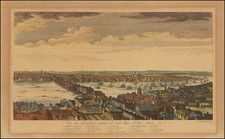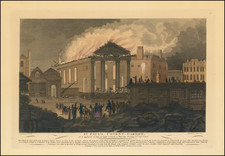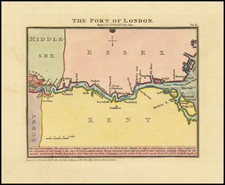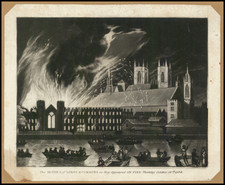"This is one of the most beautiful of all eighteenth-century garden plans." - Cohen & Taliaferro
Fantastic 18th-century engraved garden plan by John Haynes, depicting the Chelsea Physic Garden, perhaps the most important English botanical garden prior to the 19th century.
The Chelsea Physic Garden was established by the Worshipful Society of Apothecaries in 1673, as the second oldest botanical garden in England. It garnered the support of Sir Hans Sloane, and so grew to be the most richly stocked public botanical garden by the mid-18th century.
The Garden was engaged in a seed exchange program with botanists around the world. The most (in)famous result of this program was the introduction of cotton to the Colony of Georgia. Cotton was grown in North America since the 16th or early-17th century, but industrial-scale production in the Deep South was stimulated by the involvement of the Physic Garden.
The Physic Garden is located on the north side of the Thames River. Some of its historical footprint was lost to the Chelsea Embankment in 1874. The world famous Chelsea Flower Show is held annually on the grounds of the neighboring Royal Hospital.
The map includes a key that lists 14 places of interest, which perhaps most importantly shed some light on the technologies for plant growing that were in use at the Garden in the 1750s.
- The Green House.
- The dry Stove in which are disposed on Stands above each other.
- The large Bark Stove where the tender Exotic Plants of the hot Countries are kept plung'd into Beds of Tanner Bark.
- Is a low Bark Stove for raising Young Plants.
- A Glass Case where are kept the Succulent Plants which require no Artificial Heat.
- A Glass Case with Flue round it to warm the Air occasionally.
- A Frame for Sheltering such Exotic Plants as only require to be protected from hard Frost.
- A Seminary for the tender Exotic Plants.
- 9.9.9. The four large Cedars of Libanus.
- The place where the Physical Plants are place Alphabetically.
- 11. The Bulbous Rooted Flowers.
- The Annual and Biennial Plants.
- The Perennial Plants.
- The Wilderness where many kinds of Trees grow.
The notice at the bottom of the map reads:
Publish'd according to Act of Parliament March 30st 1753, by John Haynes ENGRAVER at Michael Angelo's Head in Buckingham Court near Charing-Cross. LONDON
By whom Gentlemen may have their Estates accurately Survey'd, and Maps thereof correctly Drawn and Imbellish'd with Perspective Views of their Seats in a picturesque manner. Likewise may be taught Surveying of Land and Drawing Perspective Views &c. in a short and easy method upon reasonable considerations also Prints of all sorts Colour'd in Water Colours _ Geometry, Architecture, and Geography, Carefully Taught, and Youth Boarded.
(Price 2 - 6 plain, and 5s. Colour'd)
Rarity
The last example that we are aware of having come through the market was offered by Cohen & Taliaferro roughly 10 years ago. That example was purchased by Colonial Williamsburg.













![[London] Londres](https://storage.googleapis.com/raremaps/img/small/85152.jpg)
